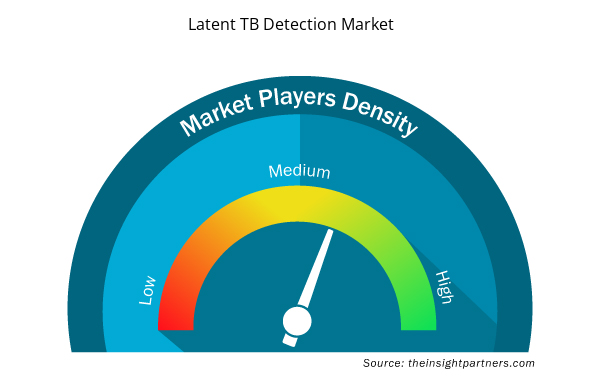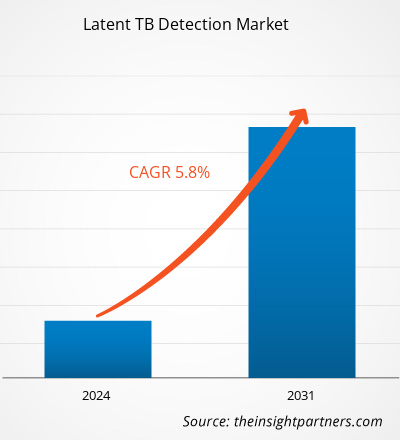潜伏性结核病检测市场规模估计在 2021 年为 12.3 亿美元,在 2023 年为 XX 亿美元,预计到 2031 年将达到 20 亿美元;预计 2023-2031 年复合年增长率为 5.8%。政府推动结核病检测的举措和结核病诊断的进步是驱动因素。结核病诊断的外包地点可能仍是潜伏性结核病检测市场的主要趋势。
潜伏性结核病检测市场分析
在结核病发病率较高的中低收入国家,医疗服务不足、药物供应有限、病例诊断不足以及社区因缺乏信息而未登记病例,所有这些都导致结核病病例增加。全球每年约有 1000 万人患结核病,超过 100 万人死亡。印度占全球结核病负担的 25% 以上,预计 2022 年结核病发病率为 277 万。此外,根据印度尼西亚的实地研究,居住在农村地区的人口对结核病病因和传播的信息有限,导致社区对结核病患者持歧视态度。因此,印度尼西亚卫生部宣布,印度尼西亚必须在 2035 年之前消除结核病。此外,2021 年,东南亚报告的结核病病例占全球的近一半,报告病例为 482 万,占 45.4%。
潜伏性结核病检测市场概况
亚太地区是潜伏性结核病检测增长最快的市场。增长主要得益于结核病患病率的上升、政府为消除结核病感染而采取的更多举措以及先进诊断产品的采用。新型潜伏性结核病检测试剂盒IGRA 比结核菌素皮肤试验提供更准确的结果。该国已启动中国传染病和地方病控制 (IEDC) 结核病项目以控制结核病感染。IEDC 项目取得了巨大成功。结果,在 1990 年至 2000 年间,结核病患者人数下降了 36.1%。然而,尽管 IEDC 项目取得了成就,但中国的结核病控制计划仍然存在问题。
定制此报告以满足您的需求
您可以免费定制任何报告,包括本报告的部分内容、国家级分析、Excel 数据包,以及为初创企业和大学提供优惠和折扣
- 获取此报告的关键市场趋势。这个免费样品将包括数据分析,从市场趋势到估计和预测。
潜伏性结核病检测市场驱动因素和机遇
政府推动结核病检测的举措
来自世界卫生组织 (WHO) 和联合国 (UN) 等各方的证据表明,亚太地区的印度和印度尼西亚等国家结核病患者数量众多。因此,这些国家的政府机构正在采取某些计划和举措来控制这种疾病。例如,旨在消除结核病的印度国家战略计划 (NSP) 于 2017 年至 2025 年制定;它为印度人设立了多个患者支持小组、保护措施、免费结核病诊断测试和治疗。此外,2019 年 5 月,疾病控制和预防中心 (CDC) 和国家结核病控制协会 (NTCA) 发布了关于医护人员结核病筛查、检测和治疗频率的最新建议。
结核病诊断的进展——一个机会
制造商和研究人员始终致力于寻找基于强效技术的新型可行解决方案,以准确诊断结核病。例如,2020 年 7 月,Cepheid, Inc. 和创新诊断基金会 (FIND) 共同建立了一种新型耐药结核病分析测试,可在 90 分钟内提供结果。此外,干扰素 γ 释放试验 (IGRA) 中基于血液的诊断的可及性减轻了临床医生的负担,他们能够提供可靠的测试结果,以高特异性和灵敏度检测潜伏性结核感染。较新的潜伏性结核病检测试剂盒干扰素-γ 释放试验 (IGRA) 提供的结果比百年历史的结核菌素皮肤试验更准确。
北美、欧洲和亚洲各国对潜伏性结核病检测诊断的采用已显著增加。
潜伏性结核病检测市场报告细分分析
有助于得出潜伏性结核病检测市场分析的关键部分是产品类型、便携性、治疗类型、应用和最终用户。
- 根据检测结果,潜伏性结核病检测市场细分为结核菌素皮肤试验(TST) 和干扰素相关伽马试验 (IGRA)。干扰素相关伽马试验 (IGRA) 部分在 2023 年占据了最大的市场份额。此外,预计在预测期内,类似部分将在市场上实现最高的复合年增长率。
- 根据最终用户,潜伏性结核病检测市场分为医院、诊断中心、实验室和其他。医院部门在 2023 年占据了最大的市场份额。此外,预计同一部门在预测期内将实现最高的复合年增长率。
潜伏性结核病检测市场份额按地区分析
潜伏性结核病检测市场报告的地理范围主要分为五个地区:北美洲、亚太地区、欧洲、中东和非洲、南美洲/南美洲和中美洲。
预计未来几年,亚太地区潜伏性结核病检测市场的复合年增长率最高。亚太地区增长的特点是结核病病例增加和政府举措增加。根据世界卫生组织的估计,全球四分之一的人口患有结核分枝杆菌,5-10% 的感染者将发展为活动性结核病。其中,印度占全球结核病患者的 27%。因此,正在采取举措。例如,国家结核病消除计划在 Ni-kshay 平台上包括 Cy-TB 测试。这标志着该国结核病控制取得了飞跃。
潜伏性结核病检测市场区域洞察
Insight Partners 的分析师已详尽解释了预测期内潜伏性结核病检测市场的区域趋势和影响因素。本节还讨论了北美、欧洲、亚太地区、中东和非洲以及南美和中美洲的潜伏性结核病检测市场细分和地理位置。

- 获取潜伏性结核病检测市场的区域特定数据
潜伏性结核病检测市场报告范围
| 报告属性 | 细节 |
|---|---|
| 2021 年市场规模 | 12.3亿美元 |
| 2031 年市场规模 | 20亿美元 |
| 全球复合年增长率(2023 - 2031) | 5.8% |
| 史料 | 2021-2022 |
| 预测期 | 2024-2031 |
| 涵盖的领域 | 通过测试
|
| 覆盖地区和国家 | 北美
|
| 市场领导者和主要公司简介 |
|
潜伏性结核病检测市场参与者密度:了解其对业务动态的影响
潜伏性结核病检测市场正在快速增长,这得益于终端用户需求的不断增长,这些需求源于消费者偏好的不断变化、技术进步以及对产品优势的认识不断提高等因素。随着需求的增加,企业正在扩大其产品范围,进行创新以满足消费者的需求,并利用新兴趋势,从而进一步推动市场增长。
市场参与者密度是指在特定市场或行业内运营的企业或公司的分布情况。它表明在给定市场空间中,相对于其规模或总市场价值,有多少竞争对手(市场参与者)存在。
潜伏性结核病检测市场的主要公司有:
- 凯杰公司
- 拜耳梅里克斯公司
- F.霍夫曼罗氏有限公司
- 屋宇署
- 爱科来株式会社
- 雅培
免责声明:上面列出的公司没有按照任何特定顺序排列。

- 了解潜伏性结核病检测市场主要参与者概况
潜伏性结核病检测市场新闻和最新发展
潜伏性结核病检测市场通过收集来自一级和二级研究的定性和定量数据进行评估,其中包括重要的公司出版物、协会数据和数据库。以下是潜伏性结核病检测市场的发展列表:
- 印度血清研究所 (SII) 和 Mylab Discovery Solutions 推出了一种即时皮肤测试,用于检测潜伏性结核感染 (LTBI),两家公司声称其成本比同类测试低 50-70%。通过多种干预措施,这一伙伴关系致力于结核病的诊断、治疗和预防。(来源:印度血清研究所 (SII)/新闻稿,2023 年 10 月)
- Mylab 推出一款可在一次测试中检测结核病和多药耐药变异株的试剂盒。该试剂盒被命名为 PathoDetect MTB RIF 和 INH 耐药性试剂盒。这款基于 RT-PCR 的精确检测试剂盒将与 Mylab Compact 设备系统一起使用,该系统可在两小时内自动检测多个样本。(来源:Reveal Lasers,新闻稿,2023 年 10 月)
潜伏性结核病检测市场报告覆盖范围和交付成果
“潜伏性结核病检测市场规模和预测(2021-2031 年)”报告对以下领域进行了详细的市场分析:
- 范围内所有主要细分市场的全球、区域和国家层面的市场规模和预测
- 市场动态,如驱动因素、限制因素和关键机遇
- 未来主要趋势
- 详细的 PEST/波特五力分析和 SWOT 分析
- 全球和区域市场分析涵盖关键市场趋势、主要参与者、法规和最新市场发展
- 行业格局和竞争分析,涵盖市场集中度、热点图分析、知名参与者和最新发展
- 详细的公司简介
- 历史分析(2 年)、基准年、预测(7 年)及复合年增长率
- PEST 和 SWOT 分析
- 市场规模价值/数量 - 全球、区域、国家
- 行业和竞争格局
- Excel 数据集


- Influenza Vaccines Market
- Webbing Market
- Dropshipping Market
- Print Management Software Market
- Quantitative Structure-Activity Relationship (QSAR) Market
- Explosion-Proof Equipment Market
- Semiconductor Metrology and Inspection Market
- Non-Emergency Medical Transportation Market
- Battery Testing Equipment Market
- Neurovascular Devices Market

Report Coverage
Revenue forecast, Company Analysis, Industry landscape, Growth factors, and Trends

Segment Covered
This text is related
to segments covered.

Regional Scope
North America, Europe, Asia Pacific, Middle East & Africa, South & Central America

Country Scope
This text is related
to country scope.
Trends and growth analysis reports related to Life Sciences : READ MORE..
The Insight Partners performs research in 4 major stages: Data Collection & Secondary Research, Primary Research, Data Analysis and Data Triangulation & Final Review.
- Data Collection and Secondary Research:
As a market research and consulting firm operating from a decade, we have published and advised several client across the globe. First step for any study will start with an assessment of currently available data and insights from existing reports. Further, historical and current market information is collected from Investor Presentations, Annual Reports, SEC Filings, etc., and other information related to company’s performance and market positioning are gathered from Paid Databases (Factiva, Hoovers, and Reuters) and various other publications available in public domain.
Several associations trade associates, technical forums, institutes, societies and organization are accessed to gain technical as well as market related insights through their publications such as research papers, blogs and press releases related to the studies are referred to get cues about the market. Further, white papers, journals, magazines, and other news articles published in last 3 years are scrutinized and analyzed to understand the current market trends.
- Primary Research:
The primarily interview analysis comprise of data obtained from industry participants interview and answers to survey questions gathered by in-house primary team.
For primary research, interviews are conducted with industry experts/CEOs/Marketing Managers/VPs/Subject Matter Experts from both demand and supply side to get a 360-degree view of the market. The primary team conducts several interviews based on the complexity of the markets to understand the various market trends and dynamics which makes research more credible and precise.
A typical research interview fulfils the following functions:
- Provides first-hand information on the market size, market trends, growth trends, competitive landscape, and outlook
- Validates and strengthens in-house secondary research findings
- Develops the analysis team’s expertise and market understanding
Primary research involves email interactions and telephone interviews for each market, category, segment, and sub-segment across geographies. The participants who typically take part in such a process include, but are not limited to:
- Industry participants: VPs, business development managers, market intelligence managers and national sales managers
- Outside experts: Valuation experts, research analysts and key opinion leaders specializing in the electronics and semiconductor industry.
Below is the breakup of our primary respondents by company, designation, and region:

Once we receive the confirmation from primary research sources or primary respondents, we finalize the base year market estimation and forecast the data as per the macroeconomic and microeconomic factors assessed during data collection.
- Data Analysis:
Once data is validated through both secondary as well as primary respondents, we finalize the market estimations by hypothesis formulation and factor analysis at regional and country level.
- Macro-Economic Factor Analysis:
We analyse macroeconomic indicators such the gross domestic product (GDP), increase in the demand for goods and services across industries, technological advancement, regional economic growth, governmental policies, the influence of COVID-19, PEST analysis, and other aspects. This analysis aids in setting benchmarks for various nations/regions and approximating market splits. Additionally, the general trend of the aforementioned components aid in determining the market's development possibilities.
- Country Level Data:
Various factors that are especially aligned to the country are taken into account to determine the market size for a certain area and country, including the presence of vendors, such as headquarters and offices, the country's GDP, demand patterns, and industry growth. To comprehend the market dynamics for the nation, a number of growth variables, inhibitors, application areas, and current market trends are researched. The aforementioned elements aid in determining the country's overall market's growth potential.
- Company Profile:
The “Table of Contents” is formulated by listing and analyzing more than 25 - 30 companies operating in the market ecosystem across geographies. However, we profile only 10 companies as a standard practice in our syndicate reports. These 10 companies comprise leading, emerging, and regional players. Nonetheless, our analysis is not restricted to the 10 listed companies, we also analyze other companies present in the market to develop a holistic view and understand the prevailing trends. The “Company Profiles” section in the report covers key facts, business description, products & services, financial information, SWOT analysis, and key developments. The financial information presented is extracted from the annual reports and official documents of the publicly listed companies. Upon collecting the information for the sections of respective companies, we verify them via various primary sources and then compile the data in respective company profiles. The company level information helps us in deriving the base number as well as in forecasting the market size.
- Developing Base Number:
Aggregation of sales statistics (2020-2022) and macro-economic factor, and other secondary and primary research insights are utilized to arrive at base number and related market shares for 2022. The data gaps are identified in this step and relevant market data is analyzed, collected from paid primary interviews or databases. On finalizing the base year market size, forecasts are developed on the basis of macro-economic, industry and market growth factors and company level analysis.
- Data Triangulation and Final Review:
The market findings and base year market size calculations are validated from supply as well as demand side. Demand side validations are based on macro-economic factor analysis and benchmarks for respective regions and countries. In case of supply side validations, revenues of major companies are estimated (in case not available) based on industry benchmark, approximate number of employees, product portfolio, and primary interviews revenues are gathered. Further revenue from target product/service segment is assessed to avoid overshooting of market statistics. In case of heavy deviations between supply and demand side values, all thes steps are repeated to achieve synchronization.
We follow an iterative model, wherein we share our research findings with Subject Matter Experts (SME’s) and Key Opinion Leaders (KOLs) until consensus view of the market is not formulated – this model negates any drastic deviation in the opinions of experts. Only validated and universally acceptable research findings are quoted in our reports.
We have important check points that we use to validate our research findings – which we call – data triangulation, where we validate the information, we generate from secondary sources with primary interviews and then we re-validate with our internal data bases and Subject matter experts. This comprehensive model enables us to deliver high quality, reliable data in shortest possible time.


 获取此报告的免费样本
获取此报告的免费样本